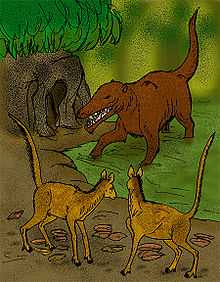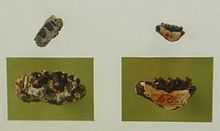Diacodexis
| Diacodexis Temporal range: Early Eocene | |
|---|---|
 | |
| Diacodexis pakistanensis and Pakicetus inachus | |
| Scientific classification | |
| Kingdom: | Animalia |
| Phylum: | Chordata |
| Class: | Mammalia |
| Order: | Artiodactyla |
| Family: | †Dichobunidae |
| Genus: | †Diacodexis Cope, 1882 |
| Species | |
| |
Diacodexis is an extinct genus of small herbivore mammal belonging to the family Dichobunidae which lived in North America and Asia from 55.4 mya—46.2 mya. and existing for approximately 9.2 million years.
Description

It is the oldest known even-toed ungulate. In life, it would have resembled a modern duiker, measuring about 50 centimetres (1.6 ft) in body length, but with a much longer tail. Unlike most later species of artiodactyl, it still had five toes on each foot, although the third and fourth toes were already elongated. It may also have had small hooves on each toe. Its teeth suggest that it was a herbivorous browser.[1]
As suggested by its long legs, Diacodexis is believed to have been fast-running, capable of leaping relatively far.
Morphology
Fossil specimens of four individuals' body mass were examined by Legendre & Roth 1988.
- Specimen 1: 3.22 kg (7.1 lb)
- Specimen 2: 2.89 kg (6.4 lb)
- Specimen 3: 2.62 kg (5.8 lb)
- Specimen 4: 2.24 kg (4.9 lb)
Fossil distribution
It was widespread, with fossils having been found in Asia, Europe, and North America.
Notes
- ↑ Palmer 1999, p. 266
References
- Legendre, S.; Roth, C. (1988). "Correlation of carnassial tooth size and body weight in recent carnivores (Mammalia)". Historical Biology 1 (1). doi:10.1080/08912968809386468.
- Palmer, D. (1999). The Marshall Illustrated Encyclopedia of Dinosaurs and Prehistoric Animals. London: Marshall Editions. ISBN 1-84028-152-9.